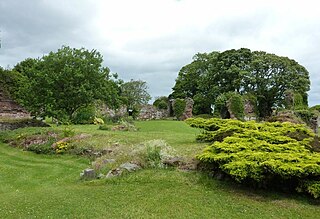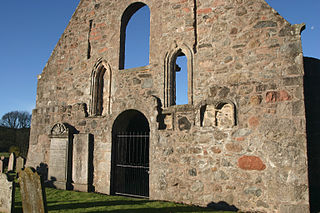Related Research Articles
The Diocese of Aberdeen was originally believed to be the direct continuation of an 11th-century bishopric at Mortlach in present-day Moray. However, this early date and the first bishops were based on a misinterpretation and reliance on the early charters found in the cartulary of Aberdeen Cathedral. These charters are now known to be false. The first recorded bishop of the diocese was Nectan, mentioned in the Book of Deer around 1132. The earliest direct written evidence of a bishop in Aberdeen appears in a papal bull addressed to Bishop Edward in 1157. This bull acknowledged the existence of his cathedral, discussed the formation of a chapter, and marked the beginning of the diocesan expansion.

Lindores Abbey was a Tironensian abbey on the outskirts of Newburgh in Fife, Scotland. Now a reduced ruin, it lies on the southern banks of the River Tay, about 1-mile (1.6 km) north of the village of Lindores and is a scheduled ancient monument.

Garioch is one of six committee areas in Aberdeenshire, Scotland. It has a population of 46,254, which gives it the largest population of Aberdeenshire's six committee areas. The Garioch consists primarily of the district drained by the River Ury and its tributaries the Shevock and the Gadie Burn.
Beóán of Mortlach is the first of the three known Bishops of Mortlach. His name, which could also be written in non-Gaelic contexts as Beanus, Beoanus and Beyn, means "lively one". Walter Bower, following John of Fordun, tells us that the bishopric was founded by king Máel Coluim II of Scotland in the seventh year of his reign as thanks to God for victories over the Scandinavians, and tells us that "the first bishop was Beyn, a saintly man, worthy of the episcopal office, elevated to this see by the Lord Pope Benedict VIII at the king's request". The Aberdeen Registrum records a charter granted to Bishop Beóán by King Máel Coluim at Forfar, granting the bishop the churches and lands of Clova and the unidentified Dulmech. The Aberdeen Breviary commemorated "Bishop Beóán" as a saint on 26 October. Another Beóán, perhaps the one mentioned in the Life of St. Cathróe of Metz, was commemorated on 16 December, and the two were often confused.
Roger de Beaumont was a 12th and 13th century Bishop of St Andrews.

The Abbot and then Commendator of Melrose was the head of the monastic community of Melrose Abbey, in Melrose in the Borders region of Scotland. The abbots of the earlier Northumbrian foundation from Lindisfarne are not included here. The second abbey was founded in 1136 on the patronage of David I, King of Scots, by Cistercian monks from Rievaulx Abbey, Yorkshire. Control of the abbey was secularized in the 16th century and after the accession of James Stewart, the abbey was held by commendators. The last commendator, James Douglas of Lochleven, resigned the abbacy to William Douglas, 6th Earl of Morton in December 1606, and the abbey itself to the king in 1608. The abbey was then erected into a secular lordship for viscount Haddington, John Ramsay, who in 1609 was created "Lord Melrose". Lochleven however resumed the title of commendator in 1613 until his death in 1620.

Henry de Lichton [de Lychtone, Leighton] was a medieval Scottish prelate and diplomat, who, serving as Bishop of Moray (1414–1422) and Bishop of Aberdeen (1422–1440), became a significant patron of the church, a cathedral builder, and a writer. He also served King James I of Scotland as a diplomat in England, France, and Italy.
Alexander de Kininmund was a 14th-century Scottish churchman. The first mention of Alexander occurs when, as a canon of Dunkeld he is one of three ambassadors sent by King Robert I of Scotland to Avignon in 1320. The purpose of this embassy was to present a letter to Pope John XXII known as the Declaration of Arbroath. As a papal chaplain and lawyer, he was well qualified to argue the Scottish cause, and Barrow makes a strong case that he was, in fact the author of the document.
Radulf de Lamley [Ralph, Ranulf, Randalph de Lambley] was a 13th-century monk and cleric. Radulf's youth is obscure, and it is not until the 1220s that he emerges in the sources as a Tironensian monk, now Abbot of Arbroath. He held the leadership of Arbroath Abbey until 1239, when he was chosen to succeed Gilbert de Stirling as Bishop of Aberdeen.
Gilbert de Stirling was an early 13th-century bishop of Scotland. His background is unclear, perhaps coming from a burgess family of Stirling; he emerges in 1228 as the newly elected Bishop of Aberdeen, succeeding the recently deceased Adam de Kalder, after Matthew the Scot had turned down his own election in order to become Bishop of Dunkeld.
Alexander Gordon was a late medieval Scottish churchman. He was member of the kindred of the Earl of Huntly, being cousin to the reigning earl. He was the third son of James Gordon, Laird of Haddo.
Robert Forman was a late medieval Scottish churchman. He was the son of one Janet Blackadder and her husband, a Berwickshire landowner named Nicholas Forman of Hatton. Sometime before 11 February 1500, he was made Precentor of Glasgow. He was Dean of Glasgow from 1505, a position he would hold until his death. Between 1506 and 1511 he was also in possession of the Chancellorship of the diocese of Moray.
Adam de Kald [de Kalder, Crail] was an early 13th-century Bishop of Aberdeen. His name, de Kald or de Caral could refer to, among other places, Calder in Nairnshire or Crail in Fife. Either location may mark his origin place, but this is speculation. There is a river in West Yorkshire called Calder. His origins remain obscure.
Matthew was a 12th-century churchman residing in Scotland. He is the first man known to have held the position of Archdeacon of St Andrews, his first known ecclesiastical post. He occurs in this office in a document which can be dated to some point between August 1147 and June 1152. Bishop Edward, Bishop of Aberdeen, died in 1172 and Archdeacon Matthew was elected as the successor. He was consecrated on 2 April 1172.
Edward [Ēadweard, Eadward, Édouard, Étbard] was a 12th-century prelate based in Scotland. He occurs in the records for the first time as Bishop of Aberdeen in a document datable to some point between 1147 and 1151. His immediate predecessor, as far as the records are concerned, was Bishop Nechtán. The latter can be shown to have been active at least between 1131 and 1132, and possibly as late as 1137. Edward's accession must have occurred, then, sometime between 1131 and 1151, with a date after the 1130s more likely than not.
James Ogilvie was a late medieval Scottish prelate who served as Bishop of Aberdeen. After the death of William Elphinstone, the bishopric of Aberdeen became vacant. Ogilvie was nominated for the vacancy by John Stewart, Duke of Albany. At Rome however, Pope Leo X provided Robert Forman to the vacant see, while the canons of Aberdeen elect Alexander Gordon, allegedly under pressure from the latter's cousin Alexander Gordon, 3rd Earl of Huntly. It was because of this that Ogilvie resigned his rights to this bishopric, and in compensation, became Commendator-Abbot of Dryburgh. During the early days of his commendatorship, it was recorded that he was a canon of the diocese of Aberdeen and the parson of Kinkell, Aberdeenshire. Ogilvie held the commendatorship for merely three years, dying on 30 May 1518.

Albin was a 13th-century prelate of the Kingdom of Scotland. A university graduate, Albin is known for his ecclesiastical career in the diocese of Brechin, centred on Angus in east-central Scotland.
Events from the 1200s in England.
Jonathan was a churchman and prelate active in late twelfth- and early thirteenth century Strathearn, in the Kingdom of Scotland. He was the Bishop of Dunblane during the time of Gille Brigte of Strathearn, and it was during Jonathan's episcopate that Gille Brigte founded an Augustinian priory at Inchaffray.

Kincardine O'Neil Hospital was founded in the 13th century in the village of Kincardine O'Neil in Scotland. Almost certainly it served as a traveler's inn and as a hospice for elderly and "poor" men. The hospital was situated adjacent to a bridge over the River Dee and may have been a chantry for the early Bishops of Mortlach. Remains of a building can be seen abutted to the Auld Parish Church in Kincardine O'Neil. This building may have been a later or second hospital. It is also possible that these ruins may have been part of St Erchard's Church - a.k.a. St Marys' or the Auld Kirk.
References
- Dowden, John, The Bishops of Scotland, ed. J. Maitland Thomson, (Glasgow, 1912), p. 101
- Innes, Cosmo, Registrum Episcopatus Aberdonensis: Ecclesie Cathedralis Aberdonensis Regesta Que Extant in Unum Collecta, Vol. 1, (Edinburgh, 1845), pp. xxi-ii
- Keith, Robert, An Historical Catalogue of the Scottish Bishops: Down to the Year 1688, (London, 1924), pp. 105–6
- Watt, D.E.R., Fasti Ecclesiae Scotinanae Medii Aevi ad annum 1638, 2nd Draft, (St Andrews, 1969), p. 1